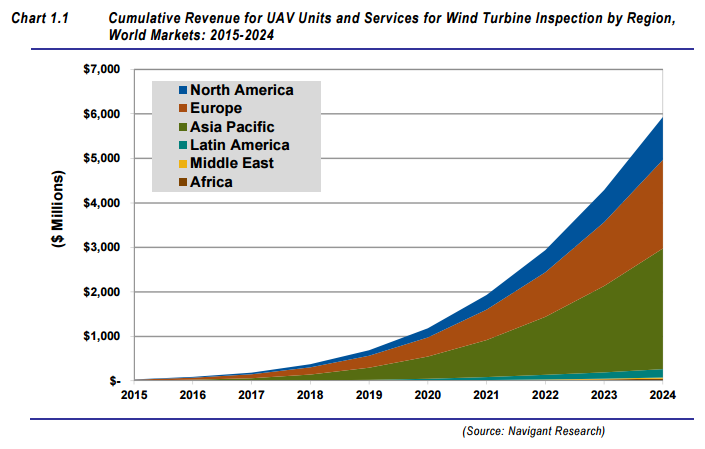Send in the Drones – Unmanned inspection vehicles for energy facilities on the rise
A new report from Navigant Research examines the global market for unmanned aerial vehicles (UAVs), commonly known as drones, for wind turbine blade inspection, including revenue forecasts by segment and region, through 2024.
To inspect the blades of the more than 270,000 wind turbines operating globally, technicians have traditionally relied on binoculars and field scopes from the ground, or have scaled the turbines with the help of ropes or cables.
Today, UAVs are providing a safer option, with the benefit of higher-resolution imaging. Click to tweet:
According to Navigant Research, cumulative global revenue for wind turbine UAV sales and inspection services is expected to reach nearly $6 billion by 2024.
“The use of drones for wind turbine blade inspection is proving to be more than a novelty,” says Jesse Broehl, senior research analyst with Navigant Research.
“Current inspection techniques from the ground and by rope or platform access will not be replaced, however, they will increasingly be augmented by drone inspections, which bring certain advantages.”

By the beginning of 2015, there were nearly 270,000 individual wind turbines operating globally.
The more than 800,000 blades spinning on these turbines are battered by the elements over time and gradually wear out.
Deterioration can cause reduced energy production in early stages and catastrophic and costly blade collapse if left unnoticed.
This is driving a brisk business in wind turbine blade inspections, a role that has traditionally been accomplished from the ground with simple visual inspections or more complicated and risky rope or platform access.
A new approach using unmanned aerial vehicles (UAVs), commonly known as drones, is rapidly muscling in as a middle option.
UAVs are proving to be more than a novelty. Commercial-grade UAVs handled by professional operators can provide higher-resolution visual inspections than ground-based inspections.
They also provide an inspection that is quicker, easier, and less costly and risky than rope access techniques. Multi-rotor UAV units with robust stability in strong winds, strong battery life, and sharp optics are essential.
Equally important is the integration of data analysis systems and inspection services that can help automate data processing and analysis to mitigate the photo fatigue that can occur photographing, analyzing, and cataloging vast blade surface image data across fleets of wind turbines.
According to Navigant Research, cumulative global revenue for wind turbine UAV sales and inspection services is expected to reach nearly $6 billion by 2024.
This Navigant Research report analyzes the global market for UAVs for wind turbine blade inspection.
The study provides an analysis of the market dynamics, industry structure, and technological features driving the market for UAV hardware and inspection services.
Global market forecasts for units and revenue, broken out by segment (multi-rotor UAVs and UAV inspection services) and region, extend through 2024.
The report also examines the key regional regulations related to UAVs, as well as the competitive landscape.



